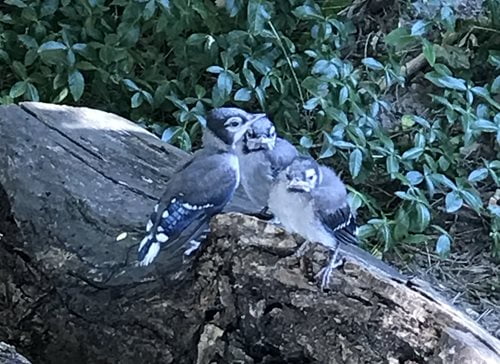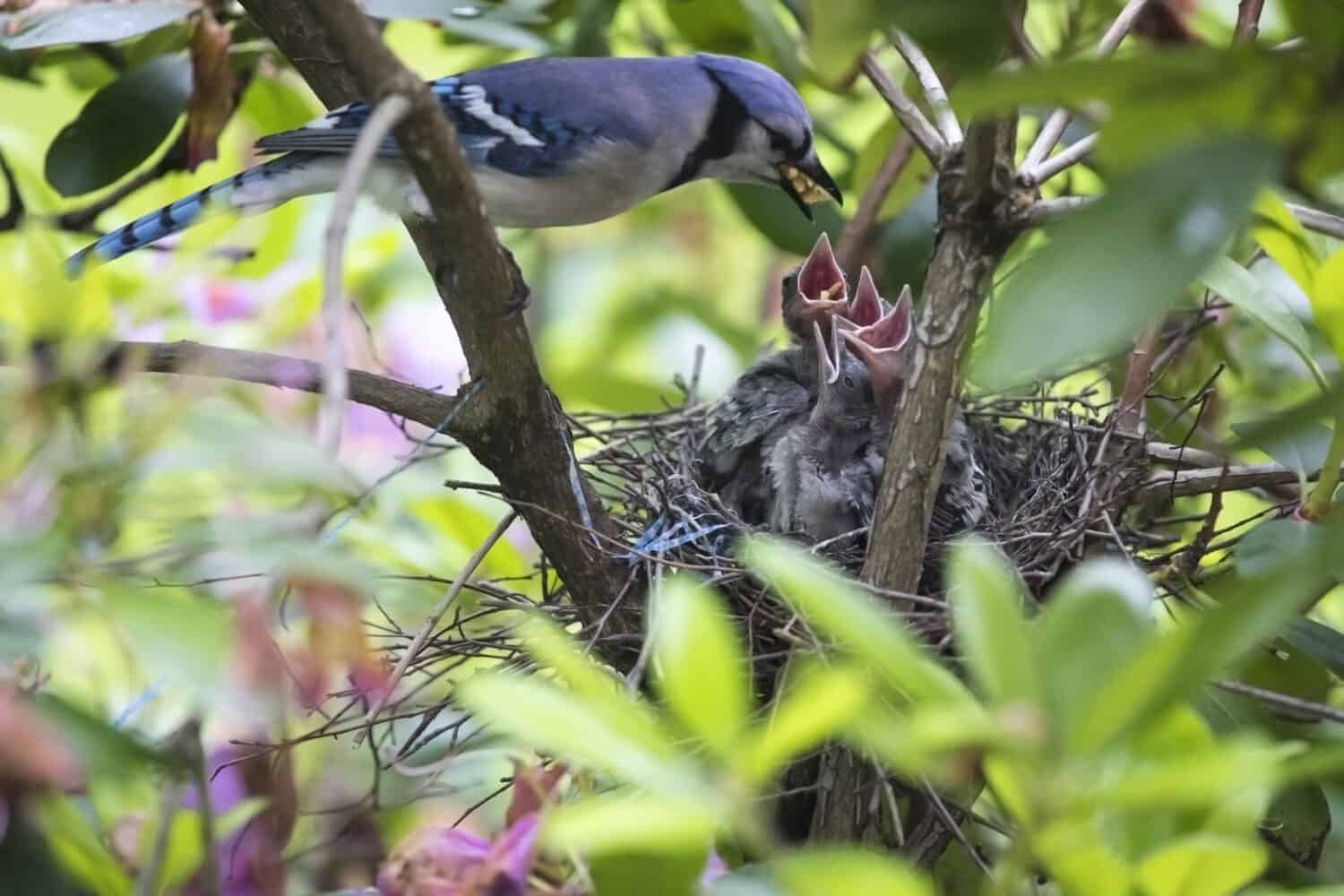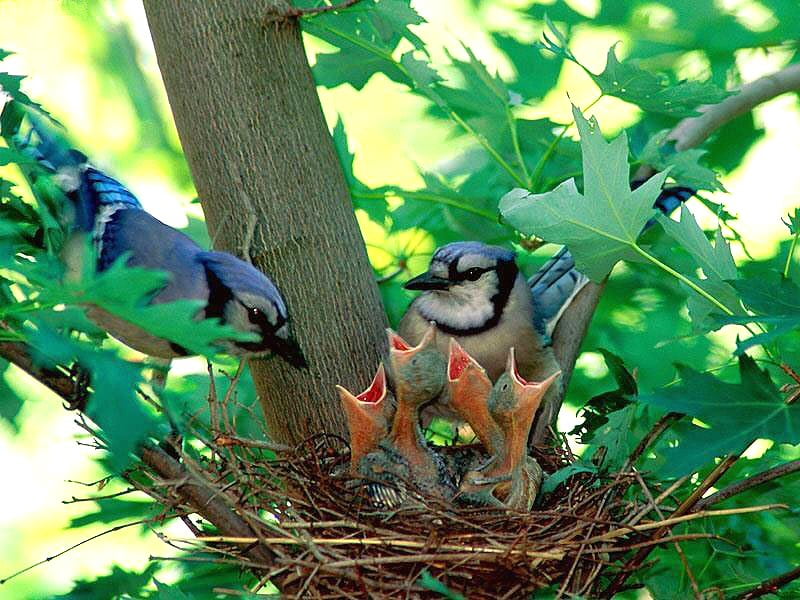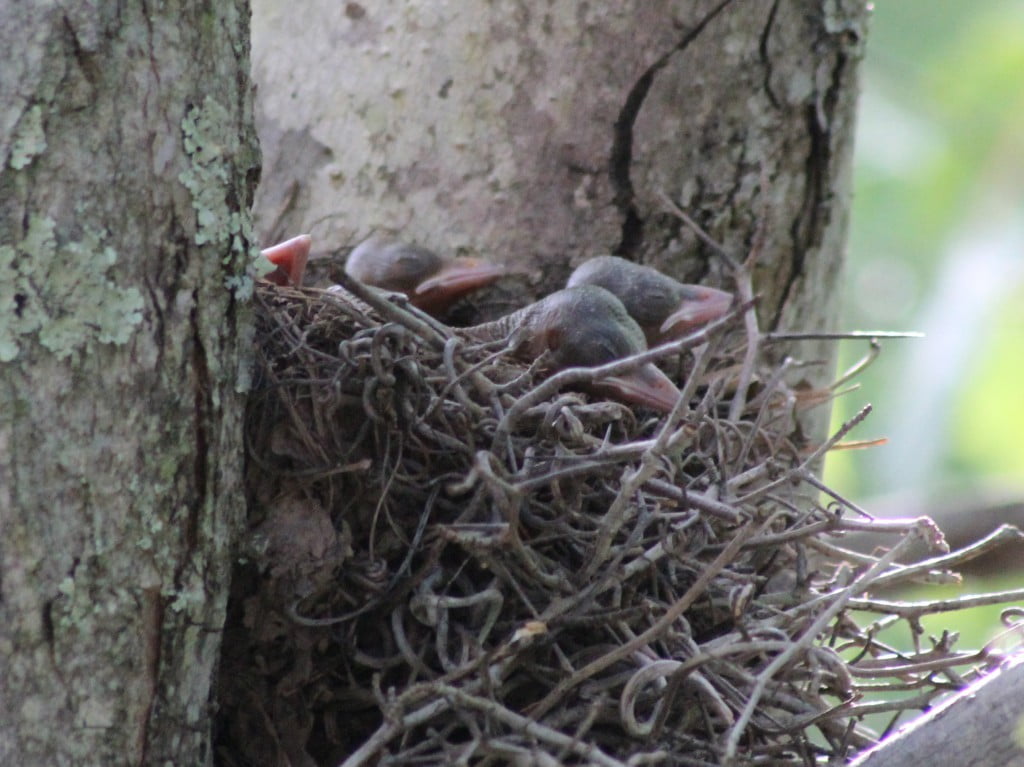A Deep-Dive into the Life of Blue Jays with Audubon Field Guide
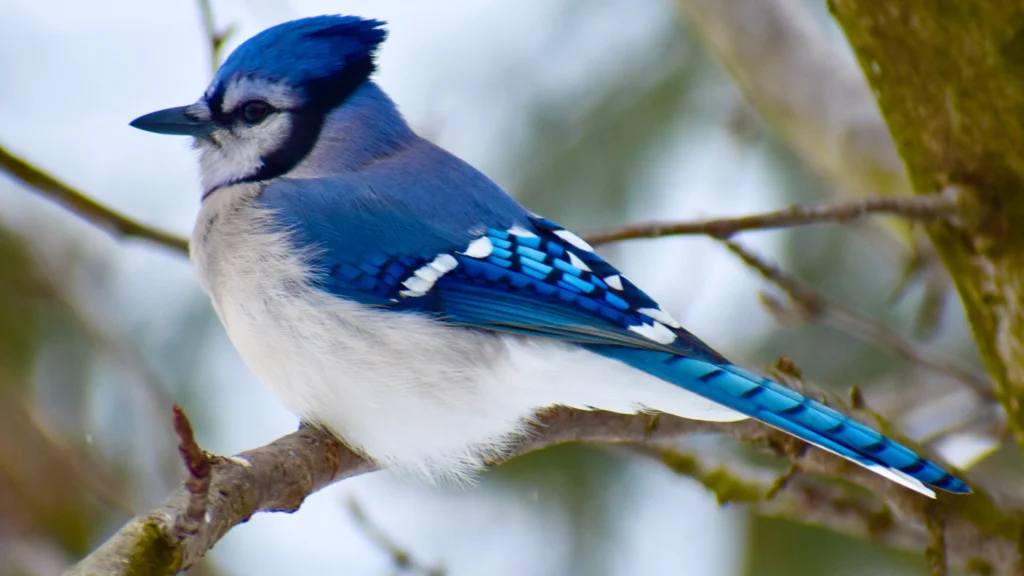
Blue Jays are birds that have beautiful blue, white, and black feathers and a pointy tuft on their heads. You can see them in many places in North America. They are very smart and interesting birds. They live in groups and have their own ways of talking and acting.
Table of Contents
ToggleTable of Contents
What Makes the Blue Jay a Fascinating Part of North American Birds?
Blue Jays are big birds that can sing and make many different sounds. They are related to crows and ravens, which are very smart and can live in different places.
They can copy the sounds of other birds, especially hawks, which are big birds that eat other animals.
They may do this to tell other jays to be careful or to trick other birds at places where people put food for them.
An In-depth Look at the Characteristics of Blue Jays
Blue Jays typically measure between 10-12 inches in size and weigh around 2.5-3.5 ounces.
They have a varied diet, consuming insects, nuts, seeds, and occasionally eggs and nestlings from other birds’ nests, although this behavior is not very common.
The Vibrant Blue Jay’s Coloration: A Blend of Blue, White, and Black Plumage



Blue Jays look blue, but they are not really blue. Blue is a special color that is hard to find in nature.
The blue color of Blue Jays is made by light bouncing off tiny changes in their feathers. This makes us see blue, but the color in their feathers is actually brown.
Understanding the Complex Social Systems of Blue Jays: Intelligence Beyond First Sight
Blue Jays are known for their complex social structures. They often mate for life and maintain tight family bonds.
During breeding season, only the female incubates the eggs while the male provides food. After the nestlings hatch, both parents participate in feeding, with the male contributing more.
How Blue Jays Interact: The Flock Dynamics
In the fall, Blue Jays become more social, forming large flocks that communicate about food sources and potential threats.
These flocks can include family groups and may stay together throughout the winter.
Their social behavior also includes food caching, particularly before bad weather, indicating their ability to sense environmental changes.
All About the Iconic Blue Crest of Blue Jays
The crest of a Blue Jay is an expressive feature that is raised for specific reasons, such as signaling agitation or alerting others to threats. Contrary to some depictions, Blue Jays do not always keep their crests raised.
Blue Jays are a remarkable species with a unique combination of beauty, brains, and complex social behaviors. Their adaptability and intelligence make them a subject of interest not only for bird enthusiasts but also for those curious about the intricate workings of avian life.
Revealing the Habitat and Distribution of the Blue Jay
The Blue Jay is a big bird that sings. Its science name is Cyanocitta cristata. You can see it in many places, from the pine trees in Florida to the fir trees in northern Ontario.
It likes to live in different kinds of places, like woods with oak and pine trees, gardens near houses, and small forests.
It makes its nest in woods with leaves that fall in autumn, but not in woods with only needle-like leaves.
A Glimpse into the Blue Jay Habitat: Comfort in Oak Trees after the Last Glacial Period
Blue Jays have a preference for habitats with many oak or beech trees. They are often common in well-wooded suburbs or city parks.
They have expertly adapted to human activity, occurring in parks and residential areas, and can adapt to deforestation with relative ease if human activity creates other means.
The Wide-Spread Distribution of Blue Jays: From Central America to Canada
The distribution of Blue Jays is extensive, ranging from southern Canada to Central America.
The western edge of their range stops where the arid pine forest and scrub habitat of the closely related Steller’s jay begins, generally in the eastern foothills of the Rocky Mountains.
Why Thousands of Blue Jays Migrate South Each Year
Blue Jays do migrate, but their migration patterns are not as straightforward as many other bird species.
Each year, groups of Blue Jays gather in flocks, with as many as fifty members, to migrate south along the East Coast and Great Lakes.
However, not all Blue Jays migrate. Some stay in their breeding territories all year, including the winter. This can vary from year to year with each individual bird.
Can Blue Jays Adapt to Different Habitats? A Study of Their Resilience
Blue Jays are known for their adaptability. They have strong beaks for cracking seeds and are one of the few birds that will cache food, saving it to eat at another time.
They are also known for being aggressive and noisy, which helps to drive other birds away from their territories. These adaptations allow Blue Jays to thrive in a variety of habitats, from forests to suburban areas.
Why The Migratory Pattern of Blue Jays Remains a Mystery
Despite the known fact that Blue Jays do migrate, much about their migration remains a mystery.
It’s still unknown whether all Blue Jays migrate or if there is a component of the population that migrates every year.
The irregularly migratory Blue Jay will travel in a flock during the seasons it chooses to migrate. These flocks usually consist of five to fifty jays, moving south by day and resting at night.
Uncovering the Blue Jay Nesting Behavior: From Twig Selection to Nestlings Care
How Blue Jays Construct Their Nests
Blue Jays build their nests in the crotch or thick outer branches of deciduous or coniferous trees, usually 10-25 feet above the ground. Both the male and female participate in the nest-building process, with the male doing more gathering and the female more building.
The construction of a Blue Jay nest involves three phases, each using different materials:
- The outer shell is made of strong fresh twigs, which the birds yank from live trees.
- The middle may include bark, moss, lichen, dry leaves, grasses, mud, bits of paper, cloth, string, or plastic.
- The cup lining is made of tough rootlets and sometimes wet, partially decomposed leaves.
Blue Jays will travel great distances to gather nest material, especially rootlets from recently dug ditches, fresh graves in cemeteries, and newly fallen trees.
The Cadence of Egg Laying and Hatching for Blue Jays
Female Blue Jays lay between 3 to 6 eggs at a time, with a new egg being laid each day.
The mother then takes on the primary responsibility of incubating the eggs, while the father diligently provides her with food and protection.
The incubation period for Blue Jay eggs lasts around 16 to 18 days. During this time, the mother keeps the eggs warm and protected, periodically turning them to ensure even heat distribution.
The color of Blue Jay eggs is a stunning mixture of pale blue or greenish-blue, with irregular brown or gray speckles scattered throughout the shell. This unique coloration serves as a natural camouflage, helping to protect the eggs from predators.
How Soon Do Young Jays Leave The Nest?
Once the Blue Jay eggs hatch, the world is greeted with delicate, blind, and helpless hatchlings.
These tiny creatures are born with a sparse layer of downy feathers, making them appear almost bald.
The young jays, or nestlings, remain with and are fed by their parents for at least a month, and sometimes two months. There is a lot of individual variation in how quickly young become independent.
Understanding the Role of Blue Jays as Parents: From Egg to Nestling
Blue Jays often mate for life, remaining with their social mate throughout the year. Only the female incubates; her mate provides all her food during incubation.
For the first 8–12 days after the nestlings hatch, the female broods them and the male provides food for his mate and the nestlings. Female shares food gathering after this time, but male continues to provide more food than female.
Blue Jays will actively defend their nests against predators. Both parents will attack and chase hawks, falcons, raccoons, cats, snakes, squirrels, and even humans away from their nests.
Why Young Jays May Be More Likely to Migrate Than Adults
Thousands of Blue Jays migrate in flocks along the Great Lakes and Atlantic coasts, but much about their migration remains a mystery.
Young jays may be more likely to migrate than adults, but many adults also migrate.
Some individual jays migrate south one year, stay north the next winter, and then migrate south again the next year. No one has worked out why they migrate when they do.
In conclusion, the nesting behavior of Blue Jays is a fascinating process, from the construction of their nests to the care of their young.
Their adaptability, resilience, and complex social systems make them a captivating subject of study.
The Unique Habits of Blue Jays: Food Sources and Interactions at the Feeder
Blue Jays, with their striking blue plumage and distinctive crest, are a common sight in many North American backyards.
These intelligent and adaptable birds have unique habits, particularly when it comes to their food sources and interactions at bird feeders.
What Do Blue Jays Eat? Decoding the Jays’ Preference for Acorns and Other Food Sources
Blue Jays are omnivorous birds, with a diet that varies depending on the season. In the summer, they consume larger insects like grasshoppers and caterpillars. They also eat beetles, spiders, and snails.
However, the bulk of their diet consists of plant-based foods such as acorns, beechnuts, seeds, grains, and fruits. They are particularly fond of peanuts and sunflower seeds, which they often take from bird feeders.
Interestingly, Blue Jays have a unique method of breaking open hard nuts or seeds. They hold the nut with their feet and peck at it with their bill until it cracks open.
They also have a habit of storing food for later, often hiding acorns in holes in the ground or under leaves or grass clippings.
Monitoring Blue Jays at Bird Feeders: Patterns And Insights




Blue Jays are big and brave birds at bird feeders. They look like they are the boss, but they are not always. Some things that study birds have found out that Blue Jays have to deal with many other animals at bird feeders. Some of these animals are Red-headed Woodpeckers, Florida Scrub-Jays, Common Grackles, and gray squirrels. They can push Blue Jays away and not let them eat.
But Blue Jays still come to bird feeders a lot, especially if they have the food they like, such as peanuts and sunflower seeds. They also like to take food from the feeders and hide it somewhere else, like under trees and bushes. They do this more in winter, so they can eat it later.
The Peculiar Feeding Patterns of Young and Adult Jays
Both young and adult Blue Jays share similar feeding patterns. However, young Jays are often fed by their parents. Both parents bring food for the nestlings, who leave the nest 17-21 days after hatching.
As they grow, young Jays learn to forage and feed themselves, often copying the feeding behaviors of adults and even squirrels.
Do Blue Jays Store Food for Later? An Interesting Trait Explored
Blue Jays have a fascinating habit of storing food for later, a behavior known as “caching.” They often carry away food, especially acorns, from feeding stations and hide them in various places like holes in the ground, under leaves, or in grass clippings. This behavior allows them to have a food supply during times when food is scarce, such as in winter.
Why Bright Blue Disappears When Blue Jays Molt
Blue Jays have a time when they lose old feathers and get new ones. This usually happens in the summer.
During this time, some Blue Jays may look like they have no hair on their heads because they lose all their head feathers at the same time.
This is a normal thing that happens to them and is not a problem. The bright blue color of their feathers is because of how light bounces off special cells on the feathers, not because of paint.
When they lose their feathers, this bright blue color goes away for a while, but it comes back when the new feathers grow.
Blue Jays are amazing birds with different ways of eating and getting along with other birds at bird feeders.
They like to eat acorns and other things that come from plants, they have to deal with many other animals at bird feeders, they have strange ways of eating, they like to hide food for later, and they lose and grow feathers. All these things make them act in special ways and make them fun to watch and learn about.
Blue Jays and Their Interactions with Other Species: The Red-Shouldered Hawk Paradox
Blue Jays are fascinating creatures, known for their vibrant blue plumage and distinctive crests. They are highly intelligent birds, exhibiting a wide range of behaviors that intrigue and delight observers.
One of the most intriguing aspects of Blue Jays is their complex relationship with other species, particularly the Red-Shouldered Hawk.
Understanding the Complex Relationship Between Blue Jays and Hawks
Blue Jays are known for their aggressive behavior towards other species. They are very territorial and will chase others from a feeder for an easier meal. Additionally, Blue Jays may raid other birds’ nests, stealing eggs and chicks. They are also known for their aggressive mobbing behavior towards predators, which involves calling loudly and diving at the predator to scare it away.
Interestingly, Blue Jays have a unique relationship with hawks. They are known to mob hawks, owls, cats, and even humans to drive them away. Blue Jays will actively defend their nests against predators. Both parents will attack and chase hawks, falcons, raccoons, cats, snakes, squirrels, and even humans away from their nests.
Unveiling How Blue Jays Often Mimic the Call of a Hawk
One of the most fascinating behaviors of Blue Jays is their ability to mimic the calls of hawks, especially the Red-Shouldered Hawk.
They are so good at imitating hawks that it can be difficult to distinguish between the call of a Blue Jay and a real hawk.
This mimicry serves a purpose. It’s believed that these calls may provide information to other jays that a hawk is around, or may be used to deceive other species into believing a hawk is present.
This behavior can be seen as a survival strategy, allowing Blue Jays to scare away potential threats or competitors.
Decoding the Reasons Behind the Red-Shouldered Hawk-Blue Jay Connection
The connection between the Red-Shouldered Hawk and the Blue Jay is intriguing. Blue Jays are known to mimic the calls of Red-Shouldered Hawks so accurately that it can be difficult to tell the difference. This mimicry is not just for show; it serves a purpose in the survival strategy of the Blue Jay.
By mimicking the call of a hawk, Blue Jays can scare away other birds, giving them exclusive access to food sources. This behavior also helps to alert other Blue Jays of the presence of a hawk, potentially saving them from becoming prey.
The Intriguing Protection Mechanism of Blue Jays Against Predators
Blue Jays have developed fascinating self-defense adaptations. When threatened by predators, Blue Jays will use their loud calls to scare them away. They are also known to mob potential predators, diving at them in groups to drive them away.
In addition to these aggressive behaviors, Blue Jays also use more subtle tactics. For example, they become quiet and inconspicuous around their nests, but will attack with loud calls if the nest is threatened by a predator.
Exploring How Feisty Blue Jays Defend Their Territory From Invaders
Blue Jays are birds that like to have their own space and will fight to keep it. They are known for being mean to other animals and will make them go away from a feeder so they can eat more easily.
When it comes to keeping their space, Blue Jays are not scared of bigger birds. They have been seen chasing away hawks and other big birds, using their loud noises and mean actions to make them go away.
To end, Blue Jays are amazing animals with many ways of acting and getting along with other animals. Their actions with Red-Shouldered Hawks are very interesting, showing how smart and flexible they are.
Whether they’re copying the sound of a hawk to make other animals run away or attacking a possible enemy to save their nest, Blue Jays show how well they can survive in the world of birds.


